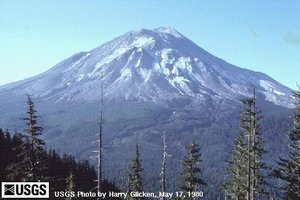Stratovolcano
|
|
Rainiersourdoughridge.JPG
A stratovolcano (also composite cone or composite volcano) is a tall, conical mountain (volcano) composed of both hardened lava and volcanic ash. The shape of these volcanoes is characteristically steep in profile because lava flows that formed them were highly viscous, and so cooled and hardened before spreading very far. Such lava tends to be high in silica. At the other end of the spectrum are shield volcanoes (such as Mauna Loa in Hawai'i), which are formed from less viscous lavas, giving them a wide base and more gently sloping profile. Many exceed a height of 2500m. Stratovolcanoes are often created by subduction of tectonic plates.
Because all volcanoes of any size have a stratified (layered) structure — that is, are built up from sequential outpourings of eruptive materials — volcanologists prefer to use the term stratovolcano for these mountains.
Examples of stratovolcanoes are:
- Cotopaxi in Ecuador
- Mount Erebus in Antarctica
- Mount Fuji in Japan
- Mount Hood in north Oregon state in the United States
- Kollóttadyngja in North-East Iceland
- Mayon Volcano in the Philippines
- El Misti in Southern Peru's city of Arequipa
- Mount Rainier in the north-central Washington state in the United States
- Mount Ruapehu in New Zealand's North Island
- Mount Shasta in northern California state in the United States
- Soufriere Hills volcano on the Caribbean island of Montserrat
- Mount Spurr in Alaska state in the United States
- Mount St. Helens in southern Washington state in the United States
- Mount Tambora Sambawa Island, Indonesia
- Mount Taranaki (formerly Mount Egmont) in New Zealand's North Island
- Teide on Tenerife, Canary Islands, Spain
- Trölladyngja in North-East Iceland
- Mount Vesuvius near Naples, Italycs:Stratovulkán

